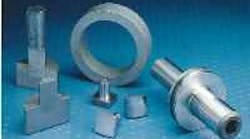WHEN CONVENTIONAL MACHINING AND INVESTMENT CASTING FAIL TO DO THE JOB, SHOPS CAN TURN TO A SPECIAL POWDERED-METAL PROCESS.
For prototypes, green billets are machined to rough form then processed to full density by the F2 technology. In addition, dissimilar metals can be diffusion bonded to PM parts.
Sometimes the old standbys — traditional machining, investment casting, EDMing, or conventional powder-metal (PM) processing — just don't measure up to the job at hand. Perhaps the workpiece is too complex or costly to manufacture using these methods. Or, in the case of PM, the part is not strong enough for its intended application. That's why PM Krupp Technologies, Chelsea, Mich., offers shops an alternative.
The company has developed a specialized niche of PM production called F2. Although the technology has been around for nearly 20 years, many manufacturers don't realize what it is and how they can best exploit it.
The F2 process produces parts that have the advantages of conventional PM technology, plus the benefit of 100% density, which provides higher strength and wear resistance. Because of this increased strength, F2-produced parts are referred to as Power/Metal parts. Like conventional PM, F2 eliminates most machining steps and produces near-net-shaped parts that may require some type of finishing operation.
PM Krupp's process has just two steps, compaction and sintering. The company fills a single-cavity die in a large-tonnage press with metal powder. Two or more punches come together to compact a "green part" that is ejected from the die. The proprietary 11-hour process can handle thousands of parts a day, depending on their size. And PM Krupp builds all punches and dies used in the process.
Where the F2 process differs from conventional PM methods is in its time/temperature profiles, which provide good strength and wear characteristics. And to make sure the parts meet performance specs, PM Krupp's operators inspect part samples for density, hole sizes, thickness, and critical dimensions. In addition, if the parts are made from tool steels, operators inspect both grain size and microstructure.
The F2 process is best suited for large quantities, such as a million parts a year, but many times, shops can justify the cost of just 15,000 parts. Although the company has processed smaller quantities, most parts are evaluated on a case-by-case basis to determine processing costs and potential savings.
Most shapes are acceptable for F2, including round, square, rectangular, triangular, and gear-shaped. A block-shaped part is better suited to the process than a long, skinny one because it is difficult to keep a high-aspect ratio straight and provide uniform density. A part does not have to be complicated, but the more complex it is, the fewer machining processes are used, and the easier it is to justify costs.
F2 parts are usually small, up to 1-in. thick with a maximum 3 1 /2 in. 2 of cross-sectional area. As a general rule, part dimensions should not exceed a 4:1 ratio.
Another consideration is material. Tool steels and high-speed steels work well because they are difficult to machine. High-carbon, low-alloy steels are good materials, as well. Although it is possible to process stainless steels, their densities with F2 are only 95%.
A part currently produced by conventional machining, in which 35% of the feed-stock is being converted into chips, is ideal for the F2 process. Parts produced by EDMing should also be considered. For example, a complex 3 /8 3 /8 3 /16-in. welding jaw that costs $15 with wire EDMing is just $2 with F2, less than 14% of the cost. Another example, a 1 1 /2-in.-diameter pinion gear with 19 teeth, costs $12 to be produced by wire EDMing, but only $6 using the F2 process.
Similar savings can be realized for certain parts produced by investment casting, conventional machining, and conventional PM.
For instance, F2 works well for conventional PM parts that are 6.4 to 7.0 gm/cm 3 , but where higher strength is required. That is because F2 produces 100% density in most materials. In fact, most low-alloy parts produced by F2 are 7.5 to 7.6 gm/cm 3 . Another advantage of F2 is its ability to shift from one material to another in the same die. For example, M4 material can replace M2 to make cutting tools using the same tooling with no other process changes. Tooling for F2 is designed according to customer part drawings. Typical tolerances for tool-steel parts are 0.003 to 0.005 in./in., depending on the specific material, shape, and density. Tolerances on low-alloy parts — F0008 and FL4608, for example — range from 0.005 to 0.010 in./in.









